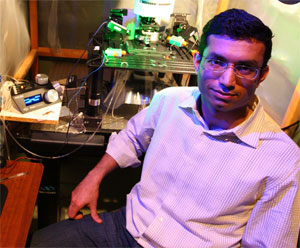 |
| Gautam Awatramani in his HВю»ӯ laboratory. (Nick Pearce Photo) |
They may just have to update the famous nursery rhyme, "Three blind mice."
When Gautam Awatramani took time off to visit friend Botond Roska at his newly established lab in Switzerland, he never thought heвҖҷd be part of a scientific breakthrough: restoring sight in mice with ever-worsening eye diseases.
A year later, the work of Dr. Awatramani and his colleagues has been published in the prestigious science journal Nature Neuroscience. Dr. Awatramani and other neuroscientists developed a strategy to restore visual functions in mice with retinal degenerative diseases, a major advancement in retinal disease research.В
Dr. Awatramani, assistant professor in the Department of Anatomy and Neurobiology at HВю»ӯ University, says the opportunity caught him by surprise: вҖңI had been doing brain research at UBC and was going to take a year off before coming to HВю»ӯ,вҖқ he says. вҖңWhen I arrived at BotondвҖҷs lab, I realized we could do something really important. It was fascinating.вҖқ
Retinal degeneration is a leading cause of blindness in humans and this research is a major step in visual function restoration. The disease results in the complete loss of photoreceptors that enable vision, thus causing blindness.
Dr. Awatramani, Pamela Lagali and David Balya worked with teams of researchers led by Dr. Roska at the Friedrich Miescher Institute in Switzerland and Constance Cepko of Harvard Medical School.
вҖңIt was an international collaborative effort between scientists with a range of expertise,вҖқ says Dr. Awatramani. The researchers successfully restored visual functions in mice with retinal degeneration disease, and while not as good as normal mice, the blind mice responded to light whereas before treatment, they didnвҖҷt.
вҖңItвҖҷs the first time a rescue of visual function with this strategy has been accomplished.вҖқ
The process uses two types of bipolar cells in the retina, ON bipolar and OFF bipolar cells. ON cells are affected by illumination and OFF cells by dimming. Their strategy expresses Channelrhodopsin, a novel, light-activated molecule found in green algae, into targeted ON cells creating artificial photoreceptors. This approach differs from current methods being developed in the US and Germany, that non-selectively stimulate output ganglion cells with miniature electrode implants, in attempts to mimic effects of light.
вҖңThe retina isnвҖҷt a simple screen that detects visual images and sends them to the brain. ItвҖҷs a complex multiprocessing unit and visual information is largely decomposed into different features when it reaches the ganglion cells,вҖқ says Dr. Awatramani. вҖңWe developed a strategy expressing the molecule channelrhodopsin in bipolar cells that normally lie downstream from photoreceptors, thus allowing the remnant retinal circuits to perform their normal extractions.вҖқ
The breakthrough has created a buzz in the neuroscience and ophthalmology community. вҖңThis may be the technology that brings the breakthrough for prosthetic devices for restoration of vision,вҖқ says Steve Barnes, director of the HВю»ӯ Neuroscience Institute. вҖңIt may be possible to duplicate what the complex circuitry of the retina does for our vision, but without photoreceptors.вҖқ
вҖңThat one can target a specific cell type in the retina and make it light sensitive is a marvelous achievement,вҖқ says John Dowling, professor of Neuroscience at Harvard. вҖңNature Neuroscience is a top journal and there will be much interest from the vision and ophthalmic research community.вҖқ
While the solution for complete recovery of vision hasnвҖҷt been discovered, Dr. Awatramani believes this work will lead to a breakthrough. Human clinical trials, headed by leading European ophthalmologist Jose Sahel, will take place in Paris with the hope of restoring visual function in human retinal degenerative diseases.
Dr. Awatramani will continue research at HВю»ӯвҖҷs Retina and Optic Nerve Research laboratory and collaborate with Dr. Roska in Switzerland. HeвҖҷll also work with pioneering genetic engineer Raj Awatramani at Northwestern University in Chicago.
The next steps include targeting OFF bipolar cells to restore greater visual function in both the brightening and dimming circuits: вҖңWeвҖҷre only at the beginning. ThereвҖҷs still much research to be done,вҖқ he notes.
